Vortex Rossby Wave Theory and Literature
The term ‘vortex
Rossby wave’ (VRW) and a formal theory for the propagation and
interaction of the
waves with the mean flow was first presented by Montgomery and
Kallenbach
(1997) and later generalized by McWilliams et al. (2003).
They showed that the axisymmetrization of potential vorticity
(PV)
anomalies, such as those generated through moist-convective processes,
by the
strong horizontal shear of the mean vortex was accompanied by outward
propagating VRWs that accelerated the tangential winds near the radius
of wave excitation. The VRWs propagated
on
the radial gradient of mean storm vorticity, analogous to Rossby waves
in the
large-scale circulation (MacDonald 1968). Montgomery
and Enagonio (1998) and Möller and
Montgomery (1999, 2000) used a three-dimensional quasigeostrophic model
and a
fully non-linear asymmetric balance model, respectively, to show
tropical
cyclogenesis and intensification could occur through the
axisymmetrization and
ingestion of like-signed PV anomalies by a parent vortex with a
monopole
vorticity structure. Furthermore,
through the continual injection of PV pulses (to simulate the effects
of continuos convection), Möller and Montgomery (2000) showed that
an
initially
tropical storm-strength vortex could develop a warm core and attain
hurricane
strength on realistic time scales.
Tropical cyclones
exhibiting monopoles of vorticity are, however, likely to occur only
during the
tropical storm and weak hurricane stages of development, while rapidly
intensifying or mature hurricanes with well-developed eyewalls usually
exhibit
rings of elevated PV on the inner edge of the eyewall (Kossin and
Eastin 2001;
Mallen et al. 2005). Wang (2001,
2002a,b) showed that the asymmetric structure within 70 km of the
center of his
modeled vortex with an annular tower of PV
was dominated by wavenumber 1 and 2 VRWs. Similar
results
were found by Chen et al. (2003), who showed that the leading modes in
wave
activity in the core were VRWs, generated in the lower eyewall through
diabatic
heating. The waves were found to be well
coupled to convection as the enhanced vertical velocity associated with
the
wave led to the appearance of inner spiral rainbands (Chen and Yau
2001; Wang
2002b).
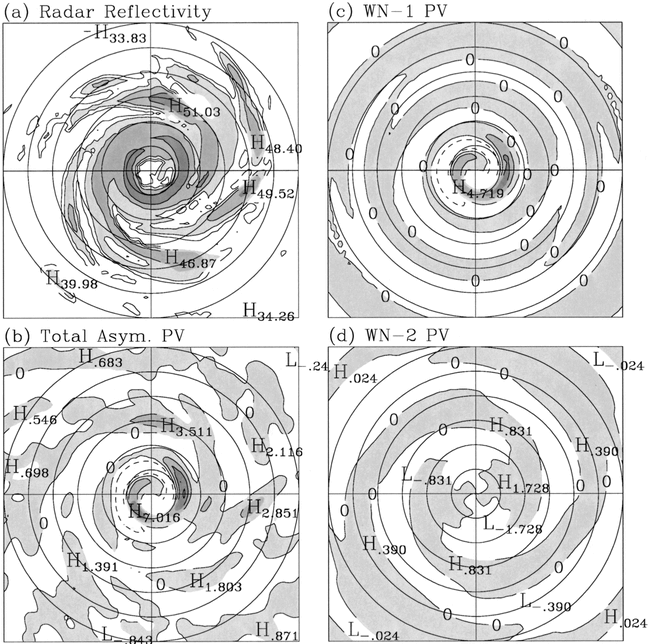
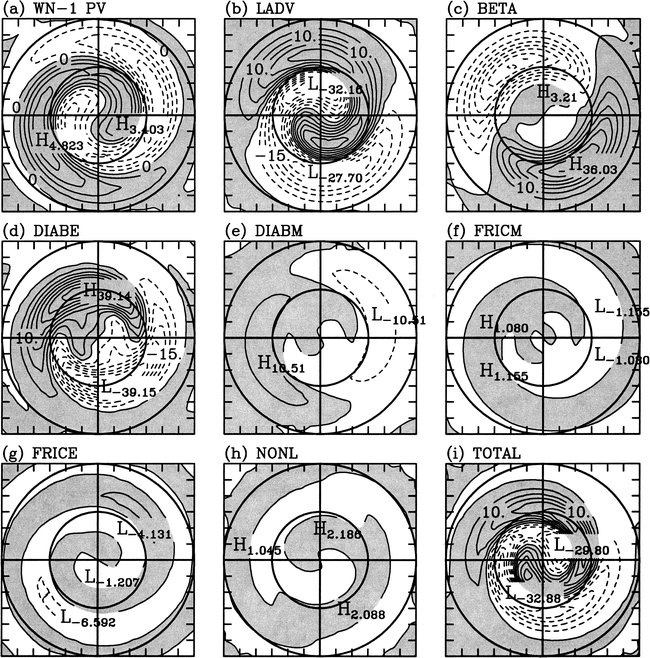
Unlike their monopole vortex counterparts discussed
previously, numerical simulations of vortices with annular PV rings
have failed
to document a consistent influence of VRWs on the intensity of the mean
vortex. Chen and Yau (2001), Möller
and Shapiro
(2002), and Chen et al. (2003) documented maximum VRW activity near the
radius
of maximum wind (RMW), and the transport of high angular momentum and
PV by the
VRWs radially inward, from the eyewall towards the eye.
This inward transport of high vorticity by
VRWs was associated with intensification, as the maximum tangential
wind
spin-up occurred just inside the RMW, causing the RMW to propagate
inward with
time and leading to contraction of the eyewall.
On the other hand, Wang (2002b) and Chen and Yau (2003) found
VRW-mean
flow interactions tended to inhibit strengthening as the VRWs acted to
spin up
the tangential winds directly in the eye and decelerate the winds at
the RMW.
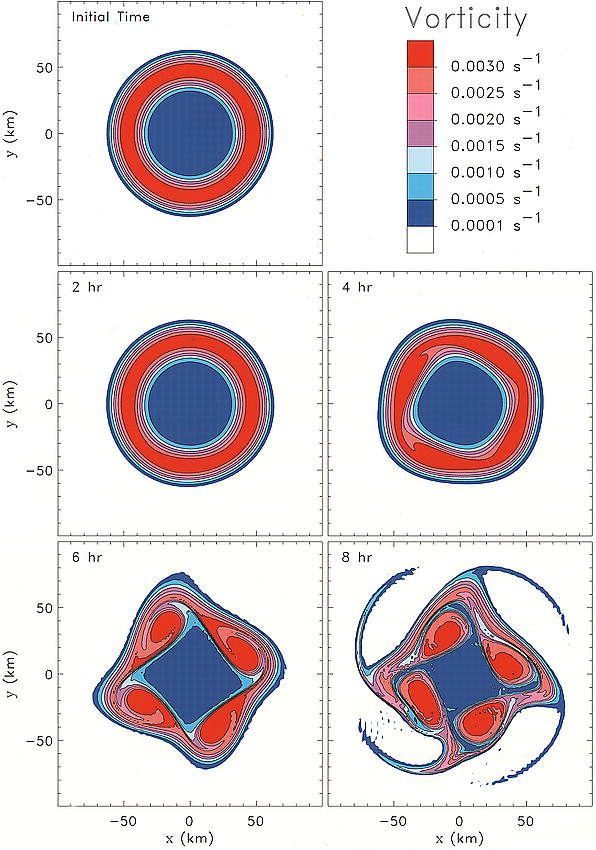
Further complicating the dynamics in storms with
elevated rings of vorticity in the eyewall is the possibility of
barotropic
instability. Schubert et al. (1999) showed
that an annular vorticity structure contains
counterpropagating
VRWs with respect to the flow on its inner and outer vorticity
gradients. If these waves became
phase-locked, they grew
in concert and led to the exponential instability of the ring, whereby
the
eyewall vorticity pooled into discrete areas, creating mesovortices. Depending
on the initial conditions of the PV
ring, the mesovortices either merged over time and relaxed to a
monopole
(Schubert et al. 1999; Chen and Yau 2003), or remained separate to form
a
quasi-steady rotating lattice of vortices that gave the appearance of
elliptical (two mesovortices) or polygonal (four or more mesovortices)
eyewalls
(Kossin and Schubert 2001). In either
case, the asymmetric mixing by the mesovortices between the eye and
eyewall
brought high eyewall vorticity into the eye and low vorticity from the
eye
outward. In order to conserve angular
momentum during such a rearrangement, some high eyewall vorticity
was
also
mixed outward, taking the form of vorticity filaments, or spiral
bands
with VRW characteristics (Kuo et al. 1999; Schubert et al. 1999).
Left, Figure 3a of Schubert et al. (1999): Vorticity
contour plots for the representative experiment. The model domain
is 600
km x 600 km, but only the inner 200 km x 200 km is shown. The
contours
begin at 0.0005 s-1. Low vorticity values are shaded
blue and high vorticity values
are shaded red. Vorticity from 0 h to 8 h is shown.
Given the copious
amount of numerical modeling studies dealing with VRWs in recent years,
it is
somewhat surprising that only a handful of observational studies have
examined
convective asymmetries in the core of tropical cyclones and evaluated
whether
they exhibit the properties of the VRWs seen in numerical models. Muramatsu (1986) documented 15 h of
counterclockwise rotating eyewall shapes in Typhoon Wynne (1980). He made a fascinating analogy between
polygonal eyewalls and the multiple vortices sometimes seen rotating
around the
inside of a parent tornado vortex, and noted barotropic instability as
a
possible cause of both phenomena. Kuo et
al. (1999) and Reasor et al. (2000) documented elliptical eyewalls in
Typhoon
Herb (1996) and Hurricane Olivia (1994), respectively.
Both studies noted elliptical eyewalls that
rotated at approximately half the maximum tangential wind speed (Vmax)
with deep convection located at the ends of the major axis of the
ellipse.
Other observational studies
have confirmed the barotropic modeling results of
Schubert et al. (1999) and Kossin and Schubert (2001) by documenting
the
existence of multiple mesovortices in the eye and substantial mixing
between
the eye and eyewall. Kossin et al.
(2002, 2004) and Kossin and Schubert (2004) showed spectacular
photographic and
satellite imagery of low-level vortical swirls in the eyes of multiple Atlantic and Pacific basin tropical cyclones
that closely
resembled the long-lived mesovortices of Kossin and Schubert (2001). Using flight-level reconnaissance data,
Kossin and Eastin (2001) showed that the radial profiles of vorticity
and
equivalent potential temperature can undergo a
rapid transition from a
barotropically unstable regime with maximum values of vorticity and
equivalent potential temperature
in the eyewall, to a stable regime with both maxima in the eye. Knaff et al. (2003) found that the
development of annular hurricanes was systematically preceded by a
dramatic
asymmetric mixing event between the eye and the eyewall involving one
or more
mesovortices.
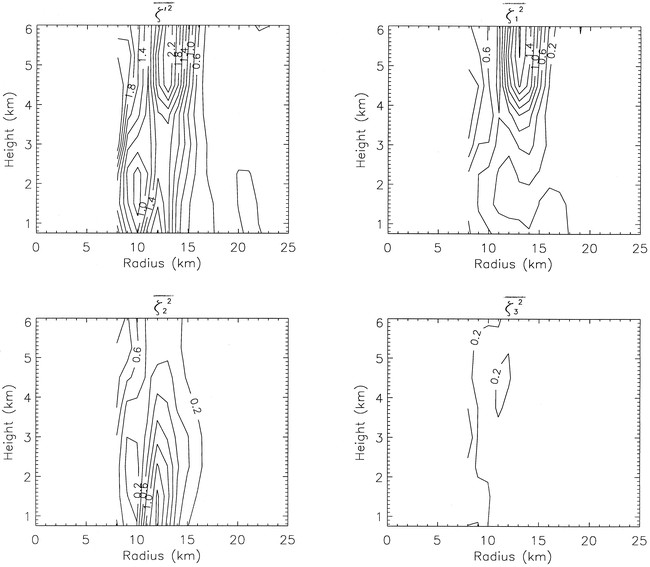
The most complete observational
investigation of asymmetric vorticity dynamics and VRWs in the core of
a
tropical cyclone was carried out by Reasor et al. (2000) in Hurricane
Olivia
(1994). The vorticity asymmetry in the
core was dominated by azimuthal wavenumber 2 below 3 km, and wavenumber
1 above
3 km, with maximum values of both found near the RMW.
The wavenumber 1 signature was hypothesized
to be the result of environmental vertical wind shear, as an
increase
in the
magnitude of the wavenumber 1 asymmetry coincided with an
increase in
the
magnitude of the vertical shear. The
wavenumber 2 asymmetry was found to be the most unstable wavenumber and
the
natural by-product of the breakdown of the unstable vorticity ring
that
Olivia
(1994) possessed at the beginning of the period of study.
Reasor et al. (2000) also observed trailing
bands of vorticity, 5-10 km wide, associated with high reflectivity,
outside
the eyewall of Olivia (1994). They
hypothesized that these bands were symmetrizing VRWs
resulting from the
expulsion of high vorticity air from the core during mixing.
Left, Figure 12 of Reasor et al. (2000): Radius-height
structure of the azimuthal variance of vorticity averaged over the
period
2027-2355 UTC. Also shown are the individual wavenumber
contributions
(1-3) to the azimuthal variance (i.e., wavenumber components of
vorticity squared and azimuthally averaged). Contour interval is
0.2x10-6
s-2.
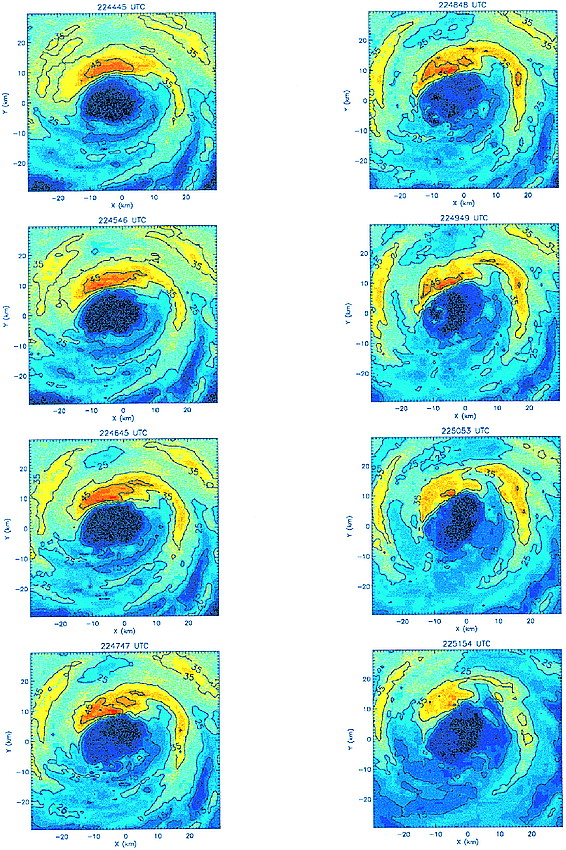
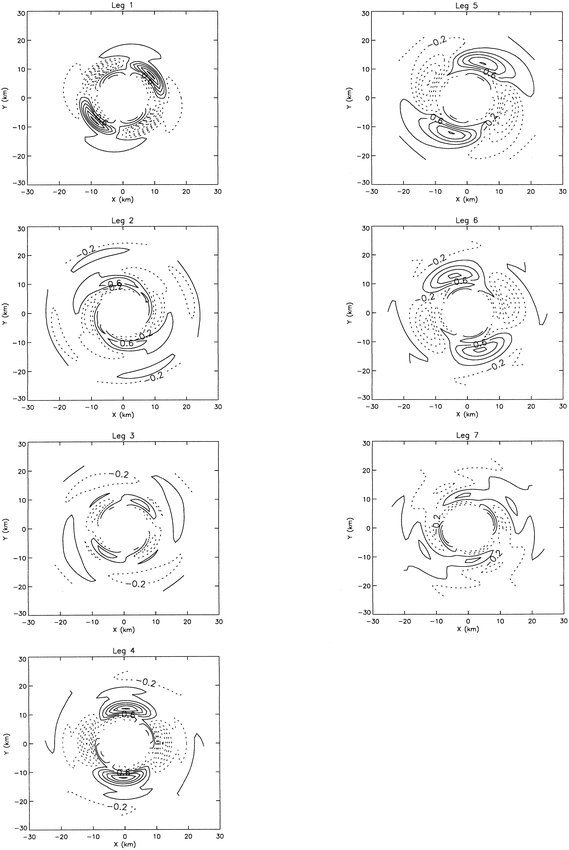
Above, Figures 15
(right) and
16 (left) of Reasor et al. (2000): (Left) Hurricane Olivia inner core
lower fuselage reflectivity composites at 3 km height. Period
spanned is 2244-2251 UTC at 1 minute intervals. The contour
interval is 10 dBZ. (Right) Azimuthal wavenumber 2 component of
vorticity vertically averaged over the lowest 3 km for each
flight. Contour interval is 0.4x10-3 s-1.
Negative values are depicted by the dashed curves.
References:
Chen,
Y., and M. K. Yau, 2001: Spiral bands in a simulated hurricane. Part I:
Vortex
Rossby wave verification. J. Atmos. Sci., 58, 2128-2145.
Chen,
Y., G. Brunet, and M. K. Yau, 2003: Spiral bands in a simulated
hurricane. Part
II: Wave activity diagnostics. J. Atmos. Sci., 60,
1239-1256.
Chen, Y., and M. K. Yau, 2003: Asymmetric structures
in a simulated landfalling hurricane. J. Atmos. Sci., 60,
2294-2312.
Corbosiero, K. L., J. Molinari, A. R. Aiyyer and M. L. Black, 2006: The
structure and evolution of Hurricane Elena (1985). Part II: Convective
asymmetries and evidence for vortex Rossby waves. Mon. Wea. Rev., 134, 3073-3091.
Knaff, J. A., J. P. Kossin, and M.
DeMaria, 2003: Annular hurricanes. Wea. Forecasting, 18,
204-223.
Kossin, J. P., and
M. D. Eastin, 2001: Two distinct regimes in the kinematic and
thermodynamic
structure of the hurricane eye and eyewall. J. Atmos. Sci., 58, 1079-1090.
Kossin, J. P., and
W. H. Schubert, 2001: Mesovortices, polygonal flow patterns, and rapid
pressure
falls in hurricane-like vortices. J. Atmos. Sci., 58,
2196-2209.
Kossin, J. P., B. D.
McNoldy, and W. H. Schubert, 2002: Vortical swirls in hurricane eye
clouds. Mon.
Wea. Rev., 130, 3144-3149.
Kossin, J. P., and W. H. Schubert,
2004: Mesovortices in Hurricane Isabel. Bull. Amer. Meteor. Soc.,
85,
151-153.
Kossin,
J. P., W. H. Schubert, C. Velden, M. Black, P. Black, R. Zehr, S.
Aberson, and
J. Dunion, 2004: Mesovortices in Hurricane Isabel (2003).
Preprints, 26th Conf. on
Hurricanes and Tropical Meteorology, Miami, FL,
Amer. Met. Soc., 447-448.
Kuo, H.-C., R. T.
Williams, and J.-H. Chen, 1999: A possible mechanism for the eye
rotation of
Typhoon Herb. J. Atmos. Sci., 56, 1659-1673.
MacDonald,
N. J., 1968: The evidence for the existence of Rossby-type waves in the
hurricane vortex. Tellus, 20,
138-150.
Mallen, K. J., M. T.
Montgomery, and B. Wang, 2005: Re-examining the near-core radial
structure of
the tropical cyclone primary circulation: Implications for vortex
resiliency. J.
Atmos. Sci., 62, 408-425.
McWilliams,
J. C., L. P. Graves, and M. T. Montgomery, 2003: A formal theory for
vortex
Rossby waves and vortex evolution. Geophys.
Astrophys. Fluid Dynamics, 97, 275-309.
Möller,
J. D., and M. T. Montgomery, 1999: Vortex Rossby waves and hurricane
intensification in a barotropic model. J. Atmos. Sci., 56, 1674-1687.
Möller,
J. D., and M. T. Montgomery, 2000: Tropical cyclone evolution via
potential
vorticity anomalies in a three-dimensional balance model. J. Atmos.
Sci.,
57, 3366-3387.
Möller,
J. D., and L. J. Shapiro, 2002: Balanced contributions to the
intensification
of Hurricane Opal as diagnosed from a GFDL model forecast. Mon.
Wea. Rev.,
130, 1866-1881.
Montgomery,
M. T., and R. J. Kallenbach, 1997: A theory for vortex Rossby waves and
its
application to spiral bands and intensity changes in hurricanes. Quart.
J.
Roy. Meteor. Soc., 123,
435-465.
Montgomery,
M. T., and J. Enagonio, 1998: Tropical cyclogenesis via convectively
forced
vortex Rossby waves in a three-dimensional quasigeostrophic model. J.
Atmos.
Sci., 55, 3176-3207.Montgomery, M. T., H. D. Snell, and
Z. Yang, 2001: Axisymmetric spindown dynamics of hurricane-like
vortices. J.
Atmos. Sci., 58, 421-435.
Muramatsu,
T., 1986: The structure of polygonal eye of a typhoon. J. Meteor.
Soc. Japan,
64, 913-921.
Reasor,
P. D., M. T. Montgomery, F. D. Marks, Jr. and J. F. Gamache, 2000:
Low-wave
number structure and evolution of the hurricane inner core observed by
airborne
dual-Doppler radar. Mon. Wea. Rev., 128, 1653-1680.
Schubert,
W. H., M. T. Montgomery, R. K. Taft, T. A. Guinn, S. R. Fulton, J. P.
Kossin,
and J. P. Edwards, 1999: Polygonal eyewalls, asymmetric eye
contraction, and
potential vorticity mixing in hurricanes. J. Atmos. Sci., 56, 1197-1223.
Wang,
Y., 2001: An explicit simulation of tropical cyclones with a triply
nested
movable mesh primitive equation model: TCM3. Part I: Model description
and
control experiment. Mon. Wea. Rev., 129, 1370-1394.
Wang, Y., 2002a:
Vortex Rossby waves in a numerically simulated tropical cyclone. Part
I:
Overall structure, potential vorticity, and kinetic energy budgets. J.
Atmos. Sci., 59, 1213-1238.
Wang, Y., 2002b:
Vortex Rossby waves in a numerically simulated tropical cyclone. Part
II: The
role in tropical cyclone structure and intensity changes. J. Atmos. Sci.,
59, 1239-1262.







